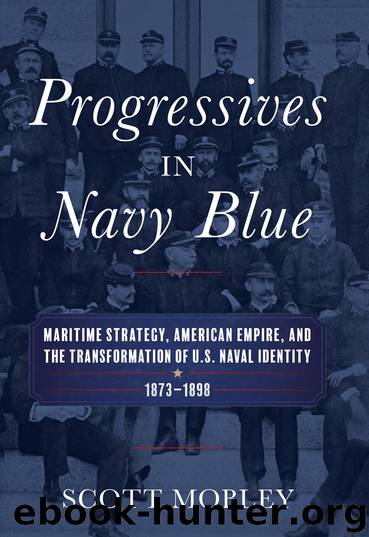Progressives in Navy Blue by Scott Mobley

Author:Scott Mobley
Language: eng
Format: epub
ISBN: 9781682471944
Publisher: Naval Institute Press
Published: 2018-04-11T00:00:00+00:00
7
“THE MEANS TO THE END”
The Navy’s Culture Wars, 1887–97
The war college was then staggering along, supported by a few men like [Henry C.] Taylor, all inspired by Admiral Luce; but it was ridiculed by most officers, and opposed by men like Commodore [Francis M.] Ramsay.
—Bradley A. Fiske, 1919
Shortly after Stephen B. Luce approached him with the concept for a war college early in 1884, Secretary of the Navy William E. Chandler summoned the four line corps bureau chiefs to consider whether to establish such an institution. This quartet wielded great power within the service. The chiefs also were notoriously resistant to changes that might disrupt their bureaucratic prerogatives. Indeed, several months before the meeting Adm. David Porter warned Luce that the bureaus composed “a Free Masonry and fellowship which makes them all cling together to keep outsiders from ‘interfering’ as they consider it, with matters concerning the Navy.”1
From Luce’s perspective, the meeting did not go well. He recalled years later that the chiefs responded “not very favorably” to his ideas.2 Ordnance Chief Montgomery Sicard reacted with particular hostility, “in a manner bordering on derision,” Luce remembered.3 Bureaucratic jealousy may have influenced Sicard’s opposition. His Bureau of Ordnance already operated a postgraduate program in Newport: the Torpedo School (established in 1869), where officers absorbed advanced coursework in science and engineering. Sicard probably looked askance at Luce’s intention to offer courses in mathematics and physics at the war college (in addition to history and strategy), as such studies would infringe upon his bureau’s educational domain.
Sicard possibly objected to the war college proposal on philosophical grounds. Deeply dedicated to advancing the Navy’s technological foundations, Sicard valued an education for line officers that emphasized mechanical and material subjects. He proudly singled out the Torpedo School for its “constant effort . . . to advance the range of our knowledge in the practical applications of electricity, chemistry, &c.”4 Along with other advocates of mechanism, Sicard saw technology as the Navy’s path to the future. To these men, precious time and budget resources would be better spent teaching naval leaders how to understand and operate technology rather than schooling them in abstract warfare theory.
In contrast to Sicard and the other bureau chiefs, only John G. Walker, chief of the Bureau of Navigation, voiced support for the new war college.5 Navy protocol recognized the navigation chief as the “senior among equals” within the bureau organization. That authority, along with Walker’s sagacious demeanor, no doubt helped to affirm Secretary Chandler’s inclinations to approve Luce’s proposal.
Chandler officially approved the Naval War College on October 6, 1884. However, despite the secretary’s strong support, opposition to the new strategic institution festered within the Navy. Most supporters, such as Walker, identified with the emerging culture of strategy. On the other hand, Sicard and some leading opponents viewed Luce’s Newport war school as a challenge to cherished bureaucratic prerogatives. Furthermore, some enemies of the college considered it inimical to priorities shaped by the culture of mechanism.
During the 1880s the two perspectives—strategy and mechanism—struggled
Download
This site does not store any files on its server. We only index and link to content provided by other sites. Please contact the content providers to delete copyright contents if any and email us, we'll remove relevant links or contents immediately.
| Automotive | Engineering |
| Transportation |
Whiskies Galore by Ian Buxton(41719)
Introduction to Aircraft Design (Cambridge Aerospace Series) by John P. Fielding(33016)
Small Unmanned Fixed-wing Aircraft Design by Andrew J. Keane Andras Sobester James P. Scanlan & András Sóbester & James P. Scanlan(32684)
Craft Beer for the Homebrewer by Michael Agnew(18081)
Turbulence by E. J. Noyes(7894)
The Complete Stick Figure Physics Tutorials by Allen Sarah(7264)
Kaplan MCAT General Chemistry Review by Kaplan(6822)
The Thirst by Nesbo Jo(6758)
Bad Blood by John Carreyrou(6476)
Modelling of Convective Heat and Mass Transfer in Rotating Flows by Igor V. Shevchuk(6353)
Learning SQL by Alan Beaulieu(6158)
Weapons of Math Destruction by Cathy O'Neil(6084)
Man-made Catastrophes and Risk Information Concealment by Dmitry Chernov & Didier Sornette(5877)
Digital Minimalism by Cal Newport;(5586)
Life 3.0: Being Human in the Age of Artificial Intelligence by Tegmark Max(5404)
iGen by Jean M. Twenge(5324)
Secrets of Antigravity Propulsion: Tesla, UFOs, and Classified Aerospace Technology by Ph.D. Paul A. Laviolette(5237)
Design of Trajectory Optimization Approach for Space Maneuver Vehicle Skip Entry Problems by Runqi Chai & Al Savvaris & Antonios Tsourdos & Senchun Chai(4957)
Electronic Devices & Circuits by Jacob Millman & Christos C. Halkias(4865)
